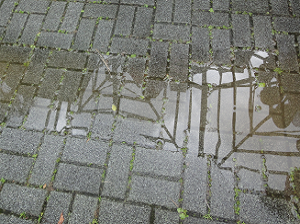Pavements
What are permeable pavements?

(photo credit: The Construction and Planning Agency)
When it comes to paving roads, the first step is to prepare the roadbed by compacting the raw surface followed by adding and then compacting layers of non-permeable asphalt or cement to make the pavement. The compacted roadbed and non-permeable pavement must be designed to withstand traffic load and volume. In addition, they must allow internal water within the city to run into the drainage system and be discharged into the river. When planning for water management in new urban areas, the goal in recent years is to increase the amount of permeable surface areas for more water to infiltrate into the soil instead of simply redirecting water flow. Therefore, it is essential to adopt the new techniques of permeable pavements. There are three types of permeable pavements:
The permeable porous material pavement
There are two kinds of porous material pavements, porous asphalt and porous concrete pavements. Between the two, porous asphalt is more commonly used and has the longest history. It uses larger-graded aggregates in the asphalt mixture to increase the porosity, which allows water to infiltrate into the soil through the gaps.
The permeable interlocking pavement
This type of pavement uses interlocking blocks that join together, forming small gaps in-between; thus, water can infiltrate through the small gaps. A wide variety of materials can be used as interlocking blocks, such as rocks, concrete bricks, permeable bricks, grass bricks, and others.
The JW Eco-Technology Pavement
This is the pavement that Jui-Wen Chen invented. It uses an aqueduct grid, combined with cement, to create the JW Eco-Technology Pavement. It is neither considered the permeable porous material pavement nor the permeable interlocking pavement.

material pavement

interlocking
pavement
pavement
Considered an expert in the field of road construction, we asked Mr. Chen how his permeable pavement is different from the others. He said that he did not study a lot and could not understand the research on this topic written in other languages. Thus, he had no knowledge of the current popular trends of road construction in the world. As a result, he was not limited by others’ ideas and was able to invent his own.
We think his revolutionary pavement had very little to do with him not studying a lot or not being influenced by the trends. We think it had more to do with him exploring his own interests as well as thinking creatively and acquiring the skills he needed by doing the work himself. These two attributes, combined with his passion for the environment, led him to invent the JW Eco-Technology Pavement that was able to combat pollution, extreme weather, and global warming.
Reference:
1. Chen, Jui-Wen. (2004). Maintenance and improvement in the ecological environment of the island: The design and application in high load-bearing structure pervious pavement.
2. Construction and Planning Agency, Ministry of the Interior
(http://www.cpami.gov.tw/chinese/)
By Gordan Huang